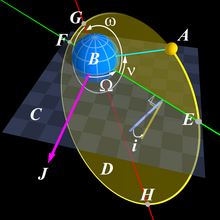
In astrodynamics, the vis-viva equation, also referred to as orbital-energy-invariance law, is one of the equations that model the motion of orbiting bodies. It is the direct result of the principle of conservation of mechanical energy which applies when the only force acting on an object is its own weight.
Vis viva (Latin for "living force") is a term from the history of mechanics, and it survives in this sole context. It represents the principle that the difference between the total work of the accelerating forces of a system and that of the retarding forces is equal to one half the vis viva...